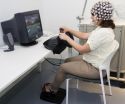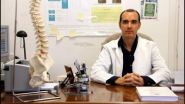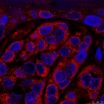(Press-News.org) Researchers from the University of Granada have shown that individual chronotype—that is, whether you are a "morning-type" or an "evening-type", depending on the time of day when your physiological functions are more active—markedly influences driving performance.
In fact, evening-types are much worse drivers—they pay less attention—at their "non-optimal" time of day (early in the morning) by comparison with their optimal time (during the evening). However, in this experiment morning-types were more stable drivers than evening-types and drove relatively well both in the morning and the evening.
In an article published in Accident Analysis and Prevention, researchers from the 'Neuroergonomía' research group of the University of Granada Mind, Brain and Behavior Center, analyzed the circadian (biological) rhythms in a sample of 29 University of Granada students with extreme chronotypes, selected from a database sample of over 500.
Early birds and night owls
Circadian rhythms—from the Latin circa, 'around', and dies, 'day'—are differences in biological variables that occur at regular intervals, such as sleep and wakefulness. "As scientists we use the simile related with birds: we tend to compare early birds—we call them sky larks—with morning-type people, and night owls with evening-types", explains Ángel Correa, principal author of the study. The University of Granada team used a questionnaire to determine issues such as when participants were most energetic or what their sleeping habits were, and a driving simulator. So, both the morning- and the evening-types were made to drive at 8.00 in the morning and 8.00 in the evening. Then they compared their driving performance at their respective optimal and non-optimal times of day.
In the light of their results, the researchers suggest that businesses should test workers to determine whether they are morning- or evening-types and adapt work schedules to suit chronotypes.
High-risk professions
"Certain professions involve performing tasks that require good attention vigilance—airline pilots, air traffic controllers, supervisors in nuclear power stations, surgeons, or lorry drivers", Correa points out.
"A particular time of day can be a good or a bad time to perform these tasks as a function of the chronotype of the individual involved, although there are times that are bad for everyone, like siesta time or in the early hours between 3.00 and 5.00", he warns.
The University of Granada researchers warn that driving after more than 18 hours wakefulness—say, at 2.00 in the early morning after waking at 8.00 the previous morning, which is quite common—"entails the same level of risk as driving with the legal maximum level of blood alcohol, because our level of vigilance declines considerably".
INFORMATION:
A study warns of the risk entailed when night owls -- 'evening-type' people -- drive early in the morning
Researchers from the University of Granada have shown that some of us are 'morning-types' and others 'evening-types', as a function of the time of day when our biological and cognitive functions are more active
2014-06-27
ELSE PRESS RELEASES FROM THIS DATE:
Colon cancer survivors are more likely to have pain in the back and abdomen
2014-06-27
Researchers from the University of Granada have discovered that colon cancer survivors are more likely to suffer future lesions related with pain in the back and lower abdomen than healthy individuals of the same gender and age.
These patients present a series of abnormalities in the abdominal wall architecture—the site of surgery in oncological treatment. Moreover, they have specific abnormalities in processing chronic pain that may increase their sensitization to any kind of pain in the future.
In two articles published in Pain Medicine and the European Journal of ...
'Big data' technique improves monitoring of kidney transplant patients
2014-06-27
A new data analysis technique radically improves monitoring of kidney patients, according to a University of Leeds-led study, and could lead to profound changes in the way we understand our health.
The research, published in the journal PLoS Computational Biology, provides a way of making sense out of the huge number of clues about a kidney transplant patient's prognosis contained in their blood.
By applying sophisticated "big data" analysis to the samples, scientists were able to crunch hundreds of thousands of variables into a single parameter indicating how a kidney ...
Global healthcare is a labour of Hercules
2014-06-27
Einstein once observed that "it is harder to crack prejudice than an atom". If he was right, then Hans Rosling is faced with a labour of Hercules. As Professor of International Health at the Karolinska Institute in Stockholm, he finds himself fighting against the cliché that the world is divided between rich and poor. "This neat division simply no longer exists. The statistics reveal a far more complex picture, with more and more people worldwide living in relative prosperity. This means that in health research in particular it is time for a paradigm shift," says Rosling. ...
Sex hormone levels at midlife linked to heart disease risk in women
2014-06-27
PITTSBURGH, June 27, 2014 – As hormone levels change during the transition to menopause, the quality of a woman's cholesterol carriers degrades, leaving her at greater risk for heart disease, researchers at the University of Pittsburgh Graduate School of Public Health discovered.
The first-of-its-kind evaluation, supported by the National Institutes of Health (NIH), was done using an advanced method to characterize cholesterol carriers in the blood and is published in the July issue of the Journal of Lipid Research.
The results call for further research to evaluate ...
New form of brain signaling affects addiction-related behavior
2014-06-27
University of Iowa researchers have discovered a new form of neurotransmission that influences the long-lasting memory created by addictive drugs, like cocaine and opioids, and the subsequent craving for these drugs of abuse. Loss of this type of neurotransmission creates changes in brains cells that resemble the changes caused by drug addiction.
The findings, published June 22 in the journal Nature Neuroscience, suggest that targeting this type of neurotransmission might lead to new therapies for treating drug addiction.
"Molecular therapies for drug addiction are ...
Homeless alcoholics typically began drinking as children
2014-06-27
WASHINGTON — A phenomenological study offers detailed insights into homeless, alcohol-dependent patients often stigmatized by the public and policymakers as drains on the health care system, showing the constellation of reasons they are incapable of escaping social circumstances that perpetuate and exacerbate their problems The study, published online yesterday in Annals of Emergency Medicine, was conducted at Bellevue Hospital in New York City, which has a long history of service to the city's indigent population.
"One hundred percent of patients enrolled in the study ...
CNIO researchers discover more than 40 melanoma-specific genes that determine aggressiveness
2014-06-27
Researchers from the Spanish National Cancer Research Centre (CNIO) have discovered more than 40 genes that predict the level of aggressiveness of melanoma and that distinguish it from other cancers with a poor prognosis. The discovery, published in Cancer Cell, will help to identify unique aspects of melanoma that could contribute to determine the risk of developing metastasis in patients with this disease. This study is relevant because it explains why a drug, also described by CNIO, is being used to selectively attack the melanoma tumour cells. Melanoma is one of the ...
NIH scientists establish proof-of-concept for host-directed tuberculosis therapy
2014-06-27
WHAT:
In a new study published in Nature, scientists describe a new type of tuberculosis (TB) treatment that involves manipulating the body's response to TB bacteria rather than targeting the bacteria themselves, a concept called host-directed therapy. TB remains a major cause of disability and death worldwide as an estimated 8.6 million people fell ill with TB and 1.3 million people died from the disease in 2012, according to the World Health Organization. Although TB is curable, adherence to therapy is difficult as treatment requires taking antibiotic drugs for at least ...
Walking the rocks: GSA Today article studies undergraduate field education
2014-06-27
Boulder, Colorado, USA – In the July 2014 issue of GSA Today, Heather Petcovic of Western Michigan University and colleagues Alison Stokes and Joshua Caulkins examine the question of geoscientists' perceptions of the value of undergraduate field education. Despite being perceived as integral to both geoscience learning and professional preparation, little research exists on the types of field experiences that carry the most value.
In their study, Petcovic and colleagues compile and analyze survey data obtained during two Geological Society of America (GSA) annual meetings ...
Research provides new theory on cause of ice age 2.6 million years ago
2014-06-27
New research published today (Friday 27th June 2014) in the journal Nature Scientific Reports has provided a major new theory on the cause of the ice age that covered large parts of the Northern Hemisphere 2.6 million years ago.
The study, co-authored by Dr Thomas Stevens, from the Department of Geography at Royal Holloway, University of London, found a previously unknown mechanism by which the joining of North and South America changed the salinity of the Pacific Ocean and caused major ice sheet growth across the Northern Hemisphere.
The change in salinity encouraged ...
LAST 30 PRESS RELEASES:
Strategic river sensors could have forewarned of Texas Camp flood disaster
Drone sampling of whale breath reveals first evidence of potentially deadly virus in Arctic
Roman soldiers defending Hadrian’s Wall infected by parasites, study finds
Pinochet’s prisoners were tormented with music but still found solace in it, a new book reveals
Fertility remains high in rural Tanzania despite access to family planning
AI-assisted device can improve autism care access
Kinetic careers
Uncovering how parasitic plants avoid attacking themselves to improve crop resistance
Nanoparticle vaccine strategy could protect against Ebola and other deadly filoviruses
Study finds brain care score can predict risk of stroke across racial groups
Key lung immune cells can intensify allergic reactions
Do hormones explain why women experience more gut pain?
New materials conduct ions in solids as easily as in liquids
Breakthrough of the Year: Renewable energy begins to eclipse fossil fuel-based sources
LLM use is reshaping scientific enterprise by increasing output, reducing quality and more
Introducing LightGen, a chip for ultra-fast, ultra-efficient generative AI
Astronomers see fireworks from violent collisions around nearby star
ACC/AHA issue new guideline on managing congenital heart disease in adults
Cosmic crash caught on camera
Is talented youth nurtured the wrong way? New study shows: top performers develop differently than assumed
Ants: An untapped resource in the development of antibiotics?
Archaeologists use AI to create prehistoric video game
Mitochondria migrate toward the cell membrane in response to high glucose levels
Tiny viral switch offers hope against drug-resistant bacteria
Most parents aware of early peanut introduction guidelines, but confused about details
HPV vaccine can protect against severe lesions of the vulva and vagina
Virtual care provision and emergency department use among children and youth
Quadrivalent HPV vaccine and high-grade vulvovaginal lesions
Insights into dry eyes gained from stem cell-derived tear glands
Researchers identify 166 human pluripotent stem cell lines available for use in clinical applications
[Press-News.org] A study warns of the risk entailed when night owls -- 'evening-type' people -- drive early in the morningResearchers from the University of Granada have shown that some of us are 'morning-types' and others 'evening-types', as a function of the time of day when our biological and cognitive functions are more active


